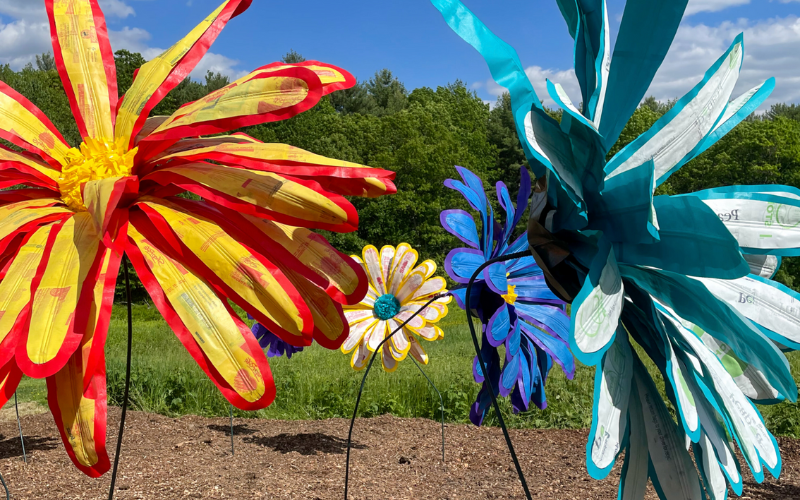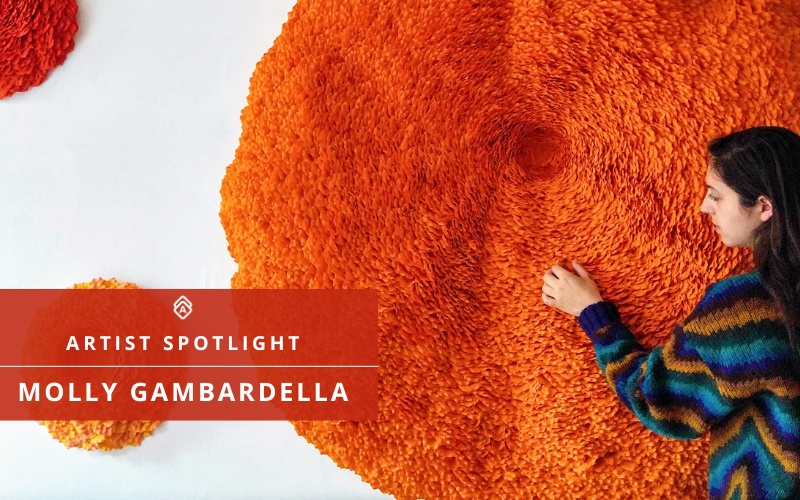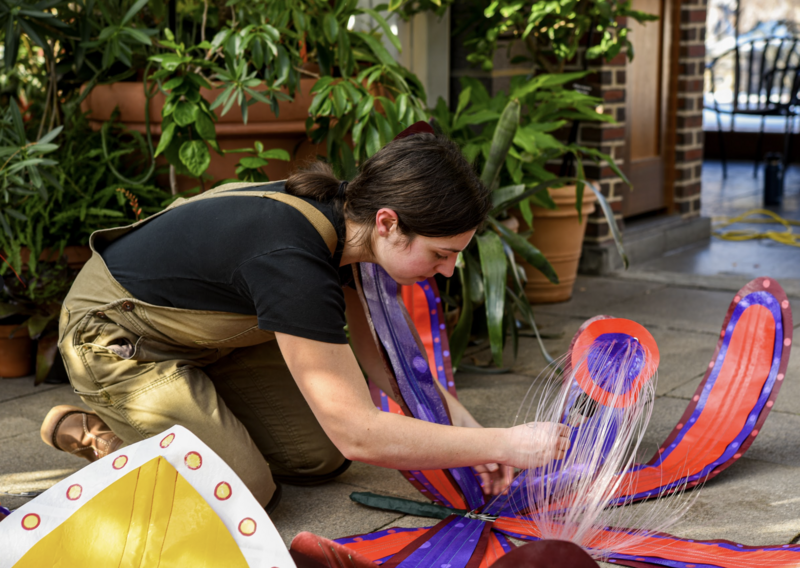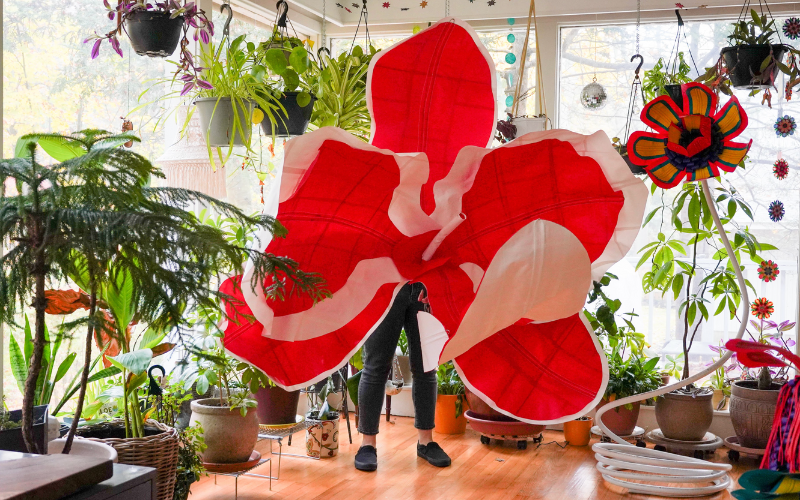"Assembling numerous small items into larger works turned into a survival skill..."
...says Featured Artist Molly Gambardella. "This practice became a meditative way to create beauty and connect with others when I couldn’t."
What began as a method of healing—using everything from plastic bags to gummy worms—grew into an expansive sculptural language. For this Connecticut based artist, her preference for round shapes, repetition, and lushness is rooted in a deeper instinct. "A universal comfort shared by humans and animals alike."
Today, Gambardella's art practice bridges interaction installation, sculpture, and public commissions. Known for her playful, densely textured forms, she builds each piece from small, often discarded materials to create something larger and more joyful, "embodying diversity and the freedom to stay alive."
Her work invites you to look closer. At what we throw away. At what we carry. At how something so small can take up space and still belong.
Artwork Archive had the chance to chat with Molly Gambardella about her creative process, how her artwork became a survival skill, and why she decided to use Artwork Archive to manage her art career.
You can see more of her work on Discovery and learn more about her art practice below:
Molly Gambardella working on a piece from her Patterns in Bloom series. Photo courtesy of the artist
When the Work Leads the Way:
For Featured Artist Molly Gambardella, the start of a piece rarely looks the same twice. Sometimes, it begins with a formal idea that pops into her head. Other times, something external—a conversation, an object, a memory—triggers a path she needs to follow. And then there are days when the research begins first and guides her creative direction.
“My process is fluid and continues to evolve with my experience as a studio artist,” Gambardella describes. That fluidity is part of what keeps her work dynamic. She moves between improvisation and planning, curiosity and execution.
Her experience with installations has deepened this instinct. “Working with installations has taught me the delicate balance between magic and logistics," she says. On any given day, she might be reworking an idea to make it physically possible, while trying to protect the core sense of curiosity that brought it into being.
Molly’s work has a way of deciding when it’s done. She pays attention, follows what feels alive, and keeps moving until the piece tells her it’s ready.
Why Circles and Abundance Keep Showing Up in Her Work
There’s a visual language that runs consistently through Gambardella’s installations and sculptures: roundness, multiplicity, and accumulation. At first glance, they might look like purely aesthetic choices. But behind the rounded shapes and multiplied materials is a deeper story of healing and survival.
Her connection to these forms started during a period of recovery from a life-threatening eating disorder. She found herself gravitating toward small, everyday materials—plastic bags, tea bags, bits of yarn and paper—and assembling them into something larger. “Intuitively, I developed a survival skill: assembling numerous small items into larger works,” she reflects. The act became meditative, something to focus on when words or connection felt out of reach. “It was a way to create beauty and connect with others when I couldn’t.”
Over time, she began to recognize that the draw toward roundness and a sense of “too-muchness” wasn't random. It mirrored something larger, something shared, and something primal. “I later realized that this preference for abundance and round forms is a universal comfort, shared by humans and animals alike—a survival instinct.”
That insight clicked into place during a pivotal backpacking trip in the White Mountains, where the artist encountered lichens for the first time. Their quiet, generative power stuck with her. “Lichens create the conditions for other life to thrive. That stuck with me,” she remembers.
Her lichen series was born out of that moment. So was a deeper understanding of what art could do. “Losing friends to the same disorder and others made me understand the value of connection and the power of art to reach a diverse audience,” she said. The forms she returns to—round, repeated, abundant—are a reflection of that commitment.
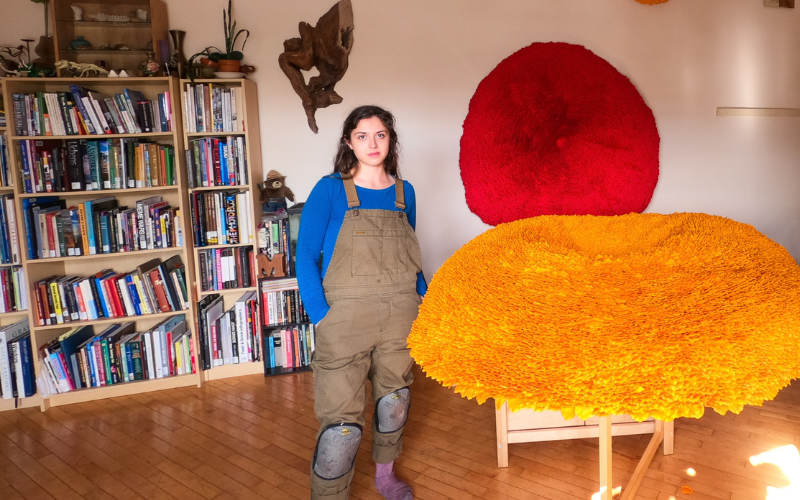
Molly Gambardella standing in front of two pieces from her Lichen series, Photo courtesy of the artist
Art as a Shared Commons, Not a Solo Act
Molly Gambardella views her art practice as a contribution to something bigger: what she calls “our cultural commons.” And it’s rooted in the way her early experiences reshaped how she thought about making anything at all.
At 18, the young artist found herself without stable housing, caught in the middle of Occupy movements across the country. That moment in her life, though difficult, offered something profound. “I learned the importance of collective thinking over individual ego,” she shares. Being part of something larger shifted her understanding of what art could do.
Her work today often focuses on the overlooked, mundane things most people skip over. In her hands, they become part of a larger conversation as she explores the poetic undercurrents that run through everyday life.
“My aim is for people to encounter my work and engage in a collective yet personal reflection, fostering a deeper understanding of our world.” For her, art is a space to meet—where people can rethink their place in the world, even if just for a moment.
Stepping Outside Routine
Creative ruts happen to every artist, and Gambardella is no stranger to them. But she's learned to notice the signs early, and has a go-to method for finding her way back to her art.
As she puts it, “When I feel disconnected from my work, stepping away from my phone and going outside helps." Sometimes it’s a hike. Other times, it’s a bike ride or just doing something that shakes up the usual routine. The key is breaking the loop long enough to return with a refreshed point of view.
“Any activity that breaks the monotony allows me to see things from a new perspective,” the artist tells us. That shift, however small, is often all it takes to re-connect and get closer to her work.
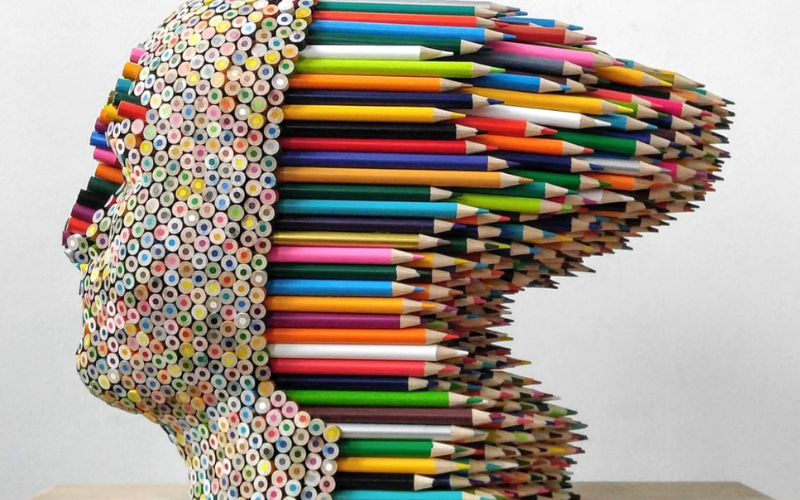
Molly Gambardella, Color Blind 3, 2019, 13 x 15 x 8 in
The Mindset Shift That Helped Her Art Practice Grow
There's a balancing act at the center of Molly Gambardella's creative practice. On one hand, she's committed to following her own rhythm, blocking out the noise of what others think she should be doing. On the other, she's learned to stay open to risk, experimentation, and evolution.
“Loving what you do is essential for sustainability,” she outlines. That kind of love, though, isn’t about staying static. It means adapting, stretching, and trusting the process, especially when the next step feels uncertain.
She credits that mindset shift—moving away from external expectations and toward internal alignment—as one of the biggest turning points in her growth as an artist. “Openness to change and taking risks are equally important,” she adds. Together, those qualities have helped her build a practice that feels both rooted and expansive.
The Hard-Learned Lesson of Shipping Sculptures
Like many emerging artists, Molly Gambardella didn’t start out thinking about shipping logistics or insurance policies. But one early sale changed that quickly.
“I sold a sculpture in my early twenties and had to ship it,” she recalls. But what should’ve been a celebratory milestone turned into a stressful ordeal. The packaging went sideways, the insurance process was a mess, and the piece ended up at the center of a legal dispute. “It was a complex experience,” she reflects, thinking back on a series of mishaps that led to a full-on court case.
“Thankfully the case was thrown out once the judge heard my side of the story,” she adds. “But it could’ve been avoided if I didn’t rely on a service to package the piece for me.”
Now she manages that part herself, especially for work that doesn’t fit in a standard box. “I learned the importance of packing or managing my unique pieces myself and handling my own insurance.” Her advice to other artists: learn to crate your work like it’s part of your practice. Because in a way, it is.
Don’t wait for a shipping scare to start documenting your work:
You never think you’ll need detailed records—until something goes wrong. Having high-res photos, dimensions, materials, and sale info already logged can save you major stress when dealing with insurance claims or legal issues.
Explore how the inventory tools on Artwork Archive can make that part second nature.
Molly Gambardella in her studio standing behind a large piece from her Pattern in Bloom series. Photo courtesy of the artist
Why She Uses Artwork Archive to Manage Her Career
As Gambardella's career picked up momentum, so did the admin. Between working with galleries, coordinating with consultants, and fielding inquiries from collectors, it quickly became clear that she needed a better way to keep everything organized.
That’s when she turned to Artwork Archive. “The inventory feature has been invaluable for organizing my work and providing easy access to details for clients and collaborators,” she explains. Instead of digging through spreadsheets or hunting for file names, she can pull up everything she needs in one place.
She also loves that she can send invoices directly from the platform. That one feature alone saves time, removes friction, and lets her keep her business running smoothly without bouncing between tools.
Inventory days no longer feel overwhelming, either. “The archiving feature is incredibly user-friendly and efficient,” she points out. “It allows me to focus more on my creative work rather than administrative tasks."
Save time when it comes to sales:
Instead of hopping between platforms, Gambardella uses the invoicing tool within Artwork Archive to send everything from one place. It keeps things clean, especially when juggling multiple contacts.
Artists also use the Contact Management feature to log conversations, track sales history, and stay on top of follow-ups.
You don’t have to keep it all in your head (or scattered across old email threads). These tools make it easier to stay connected and get paid on time.
Advice That Starts With Looking Up
If Molly Gambardella could offer one piece of advice to artists starting out, it wouldn't be about marketing or networking or how to price your work. It would be this: look up. Unplug. Get out of the scroll.
"Disconnect from digital distractions and immerse yourself in the world around you,” she encourages. That, she believes, is where and how artists begin to hear their own voice more clearly. “It's crucial to find your unique voice and stay true to your values.”
She’s also quick to remind other artists that this path isn’t always linear. It zigs, zags and opens doors when you're not looking, and sometimes closes the ones you thought you needed. Her advice? Meet that unpredictability with openness.
“Embrace the journey with openness and flexibility," she reminds us. "Being an artist is not just a career but a lifestyle that requires passion, resilience, and enjoying the ride when you can.”
